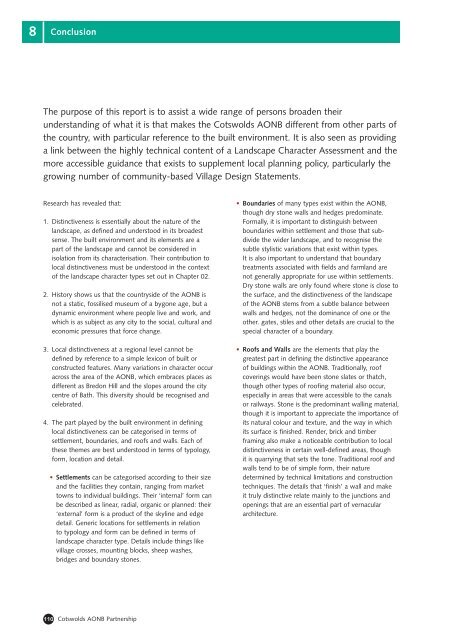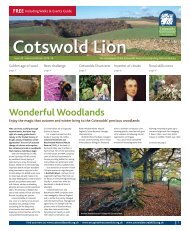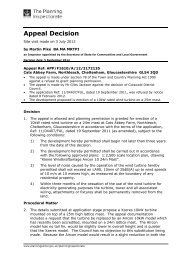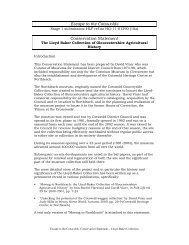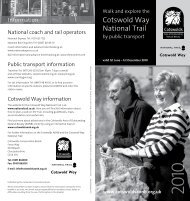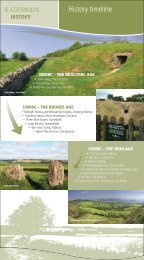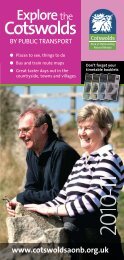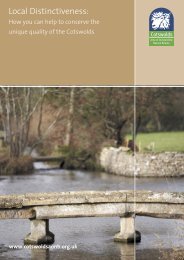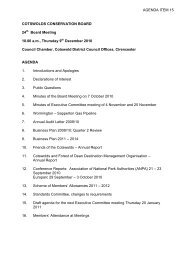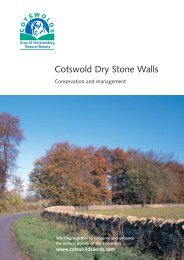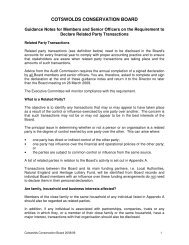8 Conclusion - Cotswolds Area of Outstanding Natural Beauty
8 Conclusion - Cotswolds Area of Outstanding Natural Beauty
8 Conclusion - Cotswolds Area of Outstanding Natural Beauty
You also want an ePaper? Increase the reach of your titles
YUMPU automatically turns print PDFs into web optimized ePapers that Google loves.
8 <strong>Conclusion</strong><br />
The purpose <strong>of</strong> this report is to assist a wide range <strong>of</strong> persons broaden their<br />
understanding <strong>of</strong> what it is that makes the <strong>Cotswolds</strong> AONB different from other parts <strong>of</strong><br />
the country, with particular reference to the built environment. It is also seen as providing<br />
a link between the highly technical content <strong>of</strong> a Landscape Character Assessment and the<br />
more accessible guidance that exists to supplement local planning policy, particularly the<br />
growing number <strong>of</strong> community-based Village Design Statements.<br />
Research has revealed that:<br />
1. Distinctiveness is essentially about the nature <strong>of</strong> the<br />
landscape, as defined and understood in its broadest<br />
sense. The built environment and its elements are a<br />
part <strong>of</strong> the landscape and cannot be considered in<br />
isolation from its characterisation. Their contribution to<br />
local distinctiveness must be understood in the context<br />
<strong>of</strong> the landscape character types set out in Chapter 02.<br />
2. History shows us that the countryside <strong>of</strong> the AONB is<br />
not a static, fossilised museum <strong>of</strong> a bygone age, but a<br />
dynamic environment where people live and work, and<br />
which is as subject as any city to the social, cultural and<br />
economic pressures that force change.<br />
3. Local distinctiveness at a regional level cannot be<br />
defined by reference to a simple lexicon <strong>of</strong> built or<br />
constructed features. Many variations in character occur<br />
across the area <strong>of</strong> the AONB, which embraces places as<br />
different as Bredon Hill and the slopes around the city<br />
centre <strong>of</strong> Bath. This diversity should be recognised and<br />
celebrated.<br />
4. The part played by the built environment in defining<br />
local distinctiveness can be categorised in terms <strong>of</strong><br />
settlement, boundaries, and ro<strong>of</strong>s and walls. Each <strong>of</strong><br />
these themes are best understood in terms <strong>of</strong> typology,<br />
form, location and detail.<br />
• Settlements can be categorised according to their size<br />
and the facilities they contain, ranging from market<br />
towns to individual buildings. Their ‘internal’ form can<br />
be described as linear, radial, organic or planned: their<br />
‘external’ form is a product <strong>of</strong> the skyline and edge<br />
detail. Generic locations for settlements in relation<br />
to typology and form can be defined in terms <strong>of</strong><br />
landscape character type. Details include things like<br />
village crosses, mounting blocks, sheep washes,<br />
bridges and boundary stones.<br />
• Boundaries <strong>of</strong> many types exist within the AONB,<br />
though dry stone walls and hedges predominate.<br />
Formally, it is important to distinguish between<br />
boundaries within settlement and those that subdivide<br />
the wider landscape, and to recognise the<br />
subtle stylistic variations that exist within types.<br />
It is also important to understand that boundary<br />
treatments associated with fields and farmland are<br />
not generally appropriate for use within settlements.<br />
Dry stone walls are only found where stone is close to<br />
the surface, and the distinctiveness <strong>of</strong> the landscape<br />
<strong>of</strong> the AONB stems from a subtle balance between<br />
walls and hedges, not the dominance <strong>of</strong> one or the<br />
other. gates, stiles and other details are crucial to the<br />
special character <strong>of</strong> a boundary.<br />
• Ro<strong>of</strong>s and Walls are the elements that play the<br />
greatest part in defining the distinctive appearance<br />
<strong>of</strong> buildings within the AONB. Traditionally, ro<strong>of</strong><br />
coverings would have been stone slates or thatch,<br />
though other types <strong>of</strong> ro<strong>of</strong>ing material also occur,<br />
especially in areas that were accessible to the canals<br />
or railways. Stone is the predominant walling material,<br />
though it is important to appreciate the importance <strong>of</strong><br />
its natural colour and texture, and the way in which<br />
its surface is finished. Render, brick and timber<br />
framing also make a noticeable contribution to local<br />
distinctiveness in certain well-defined areas, though<br />
it is quarrying that sets the tone. Traditional ro<strong>of</strong> and<br />
walls tend to be <strong>of</strong> simple form, their nature<br />
determined by technical limitations and construction<br />
techniques. The details that ‘finish’ a wall and make<br />
it truly distinctive relate mainly to the junctions and<br />
openings that are an essential part <strong>of</strong> vernacular<br />
architecture.<br />
110<br />
<strong>Cotswolds</strong> AONB Partnership


